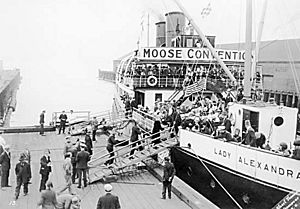Lady Alexandra facts for kids

Lady Alexandra embarking Loyal Order of Moose convention, June 3–5, 1926.
|
|
Quick facts for kids History |
|
|---|---|
| Name | Lady Alexandra |
| Route | coastal British Columbia |
| In service | 1924 |
| Out of service | 1954 |
| Identification | Canada registry #151207 |
| Fate | Wrecked 1980 |
| General characteristics | |
| Type | Coastal steamship |
| Tonnage | as built : 1,396 gross tons. |
| Length | 225 ft (68.6 m) |
| Beam | 40 ft (12.2 m) |
| Depth | 18 ft (5.5 m) depth of hold |
| Decks | three |
| Installed power | steam engine |
| Speed | 14 knots |
| Capacity | Licensed for 1,400 passengers, often carried close to 2,000. |
The Lady Alexandra was a special steamship built in 1924 in Montrose, Scotland. This ship served the coast of British Columbia from 1924 to 1952. It was mostly used for trips around Howe Sound.
Building the Lady Alexandra
The Lady Alexandra was built for trips from Vancouver to Bowen Island and Howe Sound. It was a large ship, about 225 feet long and 40 feet wide.
The ship had two powerful steam engines. These engines gave it enough power to travel at 14 knots, which is about 16 miles per hour.
The Lady Alexandra was mainly a day trip ship. It had only a few cabins for sleeping. However, it could carry a lot of people! It was allowed to carry 1,400 passengers on trips in Howe Sound. Sometimes, it even carried almost 2,000 people.
The ship had three decks. There was a dining room that could seat 86 people. It also had a big dance floor made of hardwood. The ship could carry some cargo, but it was mostly used for passengers.
The Lady Alexandra was built by Coaster Construction Co. in Scotland. Work started in October 1923. The ship was launched into the water on February 21, 1924. After testing in the North Sea, it sailed from Scotland on May 7. It arrived in Vancouver on June 21, 1924.
How the Ship Was Used
The Lady Alexandra was mostly used for fun day trips. These trips often went to the resort on Bowen Island, which was owned by the Union Steamship Company. The ship's first trip was on June 25, 1924. It took people to see the battlecruiser HMS Hood, which was visiting Vancouver.
Even though it was built for summer trips, the company thought about using it for cargo in the off-season. They wanted to carry supplies to canneries and bring back salmon. However, this only happened once. The ship rolled too much in rough waters. So, the Lady Alexandra stayed on the southern routes.
People often called the ship the Alex. When the Alexandra started service, passenger trips to Bowen Island tripled! In the 1920s and 1930s, many companies and groups in Vancouver organized big trips to Bowen Island. These were for their employees or members.
One of the biggest trips was the Longshoreman's Union annual picnic. About 3,000 people would go to Bowen Island on the Alexandra and two other ships. The Port of Vancouver would even close down for the day of this picnic!
Popular Vancouver orchestras played on the ship's "Moonlight Dance Cruises." These cruises left every Wednesday and Saturday evening. The Alexandra was also sometimes used for trips from White Rock to Victoria, British Columbia. These special trips were seasonal but made a lot of money for the company.
The crew of the Alexandra worked very long hours. They often started at 7:00 am and worked until 1:00 am. Their job included getting the ship ready, helping people get on and off, and keeping order among the many passengers. Deckhands were paid $69 per month in the 1930s for this hard work.
For many years, the captain of the Alexandra was William "Cappy" Yates. He was known for making trips fun. For example, he once delayed leaving Bowen Island to get a child's hat that had blown overboard.
End of Service
The Union Steamship Company's business slowed down in the early 1950s. In 1952, the Alexandra's trips were cut short. After the 1953 season, the ship stopped service completely.
In 1960, the ship was changed into a floating restaurant. It was docked at Coal Harbour in Vancouver. Later, it was moved to California. It was docked at King Harbor in Redondo Beach. There, it became a floating restaurant called Princess Louise II. Sadly, the ship was wrecked in a storm in March 1980.

